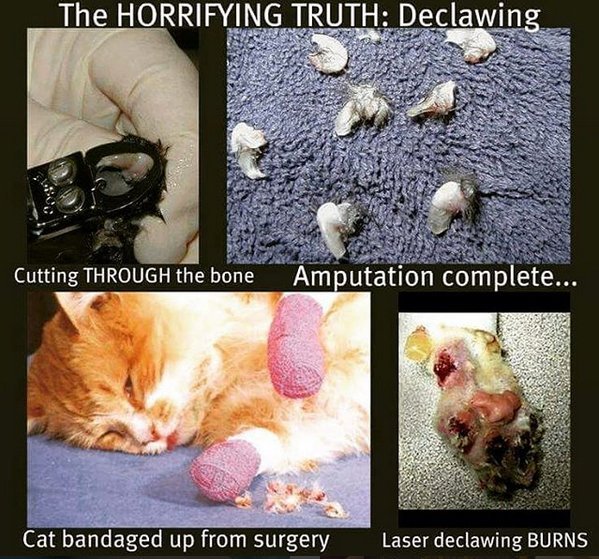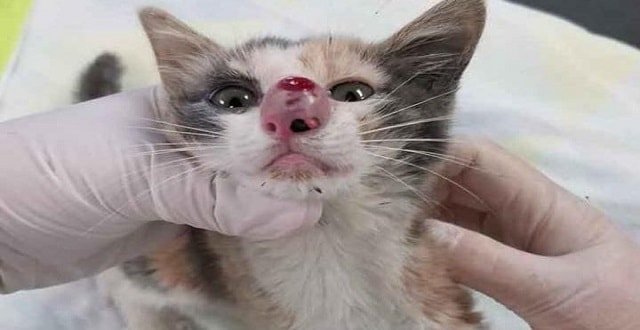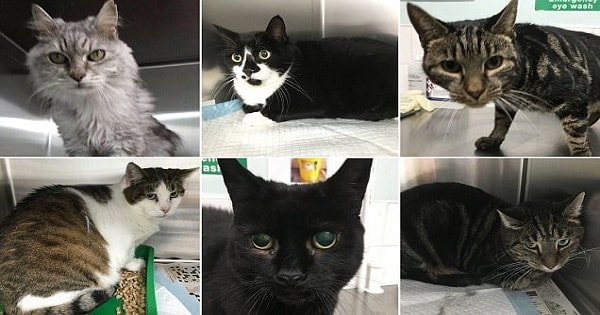Vets make huge bucks off declawing surgery—and now their leaders are spending thousands to kill a proposed ban on the procedure.
It’s just like a scene out of a torture session that the CIA would later deny: a captor drugs and ties down the victim and begins sawing through his feet, severing ligaments, tendons, and nerves, and crushing bones. The victim is then forced to walk immediately after the disfiguring procedure on his newly amputated and doleful stumps.
This sort of mutilation happens on a daily basis—luckily not to humans, but to our beloved pets in the form of cat declawing surgery. Veterinarians who perform this procedure tout it a necessary evil to protect public health and keep finicky pet owners from discarding “problematic” cats to shelters where they might be euthanized. However critics of declawing have lately been speaking out in greater numbers, claiming the antiquated service is not only purely elective, but also harmful to the very pets that vets claim to be helping.
A total of eight municipalities in California have successfully passed local bans on cat declawing, but now an unprecedented bill at the state level aims to make declawing illegal in New York. The bill, introduced in the Assembly and also backed in the Senate, has pitted animal advocates against veterinarian groups and lobbyists willing to spend tens of thousands of dollars to keep the highly profitable procedure legal.
The term declawing doesn’t sound at all so bad—removal of the tiny talons cats use to scratch. In reality, onychectomy is much more than nail removal. Whether it’s done with inexpensive guillotine clippers (the same style used to trim cat and dog toenails) or instead with a laser—which makes a cleaner cut than a clipper or a scalpel—the result is the same: an amputated paw. The rounded bones removed in declawing are the very parts which allow a cat’s foot to roll forward when it walks and distributes weight in the feet as it moves. Cats are thus left with severely reduced mobility and largely defenseless thanks to their disfigured toes, which we often don’t see because their paw tissue is left in place.
Declawing can also cause some behavioral issues—including biting, litter box problems, medical complications, and aggression. In the 2016 book Complications of Small Animal Surgery, the University of Guelph’s Ameet Singh and Brigitte Brisson have noted the risk factors for feline declawing: infection, pain and lameness, bone fragments, tendon contracture, paw pad trauma, arthritis, nerve damage, remaining bone protrusions, and nail regrowth—some of which require additional correction surgeries. They have also noted that “cats with chronic pain syndrome [post-declaw] may also exhibit behavioral changes such as increased aggression, inappropriate urination, licking or chewing at their paws, anorexia, and aversion to having their paws touched.” Without their nails to defend themselves, cats are only left with teeth to bite when they wants to be left alone or are in pain.
According to one of the largest scientific studies on why cats are surrendered as pets, published in the Journal of Applied Animal Welfare Science (PDF), nearly 14 percent of cats are given up for household soiling (litterbox mishaps), 28 percent for acting fearful, 10 percent for growling at people, and 9 percent for biting someone—all symptoms that have been linked to declawing. A 2004 study which was done by the National Council on Pet Population Study and Policy also lists house soiling and behavioral issues as top reasons owners give up their cats.
And declawing may also lead to further medical complications—including bones spurs, partial nail regrowth, and botched procedures—that require additional (expensive) surgeries.
One cat owner, who asked to stay anonymous, shared a story with The Daily Beast about a veterinarian who talked them out of Soft Paws (a small, soft vinyl sheath that can be adhered to claws, rendering them incapable of piercing surfaces without affecting a cat’s health or abilities at all) and into declawing three rescued strays. The cost for the declawing was a whopping $1,300. The average vet fee for applying nail sheaths is just $10 (and they must be replaced professionally every six weeks or so for a small fee). All three felines—Teegar, Abby, and Ryder—ended up with infections which eventually led to the complete amputation of their front feet. One cat even had to get its front legs completely removed. With costs in the tens of thousands for aftercare, the owner says their insurance company has suggested that they just completely give up and euthanize the cats.
In the later part of the 20th century, cat declawing became an increasingly common practice at most veterinary clinics. Vets informed clients that declawing protected nice furniture, prevented cats from hurting humans, and also provided an easy solution to making an animal more acquiescent. By the 1990s vets were offering two- or four-paw declawing as part of a special “boutique cat package” (vaccines, spay/neuter, check-ups, declaw). It was the pet-care equivalent of asking someone, “Do you want fries with that?” when a pet owner arrived with a new cat.

Teegar, Abby, and Ryder suffered severe complications as a result of botched declawing, leading to the amputaiton of paws and limbs.
Our empathy for cats still has much room for improvement. Comparatively, declawing dogs is completely unheard of. But in recent years, cat declawing is under more scrutiny—along with other elective pet procedures such as clipping bird wings so a pet can’t fly away, docking dog ears and tails for aesthetics, and debarking, defanging, and tattooing animals for cosmetic purposes.
One of the biggest anti-declawing boosts came from Netflix back in 2014, when it started streaming Dr. Jennifer Conrad’s The Paw Project. The documentary follows Conrad’s grassroots work as she helps exotic cats (tigers, lions, cougars, and also cheetahs) find relief from botched up declawing jobs. As she learns of the many health and behavioral issues for these large cats (and helps get a statewide California ban on exotic cat declawing passed), she then turns her attention to domesticated cats. The film also documents her effort to completely ban cat declawing in several California towns. Along the way, the film addresses the ethical issues, medical complications, and financial rewards of cat declawing. In the film, Conrad faces opposition from many veterinarians backed by aggressive lobbyists, angry that the option of declawing would be taken away from them.
Meanwhile, comprehensive behavioral studies on declawing are somewhat lacking. In 2016 declawing literature disseminated by the American Veterinary Medical Association (AVMA), studies are cited with as few as 57 cats as a sample size and some rely on data which was collected by untrained pet owners, not scientists, doctors, or animal behaviorists.
Pro-declaw vets still claim the procedure is necessary for public health and to save cats from euthanasia. The AVMA’s position on declawing is as follows:
“The decision to declaw a cat should be made by the owners in consultation with their veterinarian. Declawing of domestic cats should be considered only after attempts have been made to prevent the cat from using its claws destructively or when its clawing presents an above normal health risk for its owner(s).
The American Society for the Prevention of Cruelty to Animals (ASPCA) official position on declawing is:
The only circumstance in which the procedure could be condoned would be if the health and safety of the guardian would be put at risk.”
Sounds sensible, especially coming from two of the most powerful animal and veterinary organizations within the United States. Yet neither of the now leading organizations on human public health and safety—the World Health Organization (WHO) and the Centers for Disease Control and Prevention (CDC)—recommend declawing at all. A spokesperson for WHO pointed out to The Daily Beast that they do not take a stance on the issue, seeing it as a non-threat to public health, and even pointed out several countries that ban the practice. The spokesperson from the National Center for Emerging and Zoonotic Infectious Diseases at the CDC told reporters at The Daily Beast they do not recommend declawing in any situation, but rather dissuade immune-compromised humans from getting a cat who is under one year of age, as kittens tend to be friskier with their claws and bites. If a person with compromised immunity still wants a cat, the CDC suggests not playing at all rough with cats, washing hands, keeping cats indoors, and treating all household pets for flea prevention. No mention of declawing in their recommendations or in their studies – anywhere.
The bacterial infection Bartonella henselae—colloquially named cat-scratch fever—according to a number of medical textbooks and the CDC, can be contracted from ticks, fleas, dirt with flea feces in it, or any domestic pet that’s been bitten by a bacteria-inflicted flea. The only way for a human being to contract the bacteria is if an open wound comes into contact with the saliva and blood of a carrier or contact with flea feces. In their FAQ, the CDC notes that if someone has been scratched by some cat, “short of cleaning the wound with soap and water, there is no particular action to take.” In a few rare cases where a cat-scratch infection shows symptoms (fever, swollen lymph nodes, pustulated wound, muscles ache), they are typically self-limiting—meaning they spontaneously heal—within 3 or 12 weeks.
There are now an average of 22,000 cases of Bartonella henselae in the United States each year. A 2009 study noted that a total of 437 children (the group mostly likely to be scratched, as they play haphazardly with kittens who’ve not yet learned bite/scratch boundaries) were hospitalized for symptoms requiring treatment. In modern medical literature, there is but one case study linked to this bacterial infection that led to fatal encephalitis—in a young boy who was not immune-deficient.
With all of these statistics at hand, it is very difficult to believe declawing is necessary as a public safety measure for humans. Surveys—like the one published within veterinary journal Pulse in Nov. 2009—cite “human health” as a reason for up to 63 percent of cat declaw procedures. The survey simultaneously cites “household destruction” as a direct reason for in upwards of 95 percent of cat declaws. Some pet owners and vets appear to be twisting the “last resort” excuse to declaw cats would otherwise be surrendered for scratching furniture and other possessions.
We’re seemingly a culture of quick-fixes and cutting corners. Rather than invest in proper behavioral training of one’s pet, providing proper exercise and cat-specific scratching posts, and learning to keep cat nails trimmed or using nail covers, we turn to declawing. An estimated 14 million cats (25 percent of total current cat population) have undergone the declaw procedure, according to a study by Gary J. Patronek published in the Journal of the American Veterinary Medical Association.
Seven from the eight towns in California where cat declawing is now banned have provided reports to the Humane Society of the United States (which enthusiastically backs the NY statewide ban proposal). The Humane Society shared copies of these very reports with The Daily Beast. Each reflects a decrease in the number of cats relinquished to shelters since the ban took affect—down by as much as 43 percent in Los Angeles. While there are a number of factors that affect the decision to leave a pet at a shelter for possible euthansia (50-75 percent of cats never get to leave open access shelters, depending on the location), these reports indicate that the lack of access to declawing procedures does not necessarily lead to an increase in giving cats away to shelters.
So then just why are veterinarians still fighting to keep this animal surgery legal?
Dr. Jennifer Conrad of The Paw Project told The Daily Beast that declawing has almost no overhead cost to vets at all and is typically suggested as an add-on when a cat must undergo anesthesia for other procedures, such as spaying/neutering. At an average cost of $200-$350 per cat for the 10-minute declaw procedure, with some vets running “sales” on declawing for as low as $75 just to entice a high volume of customers, it’s an easy “cash cow” for some veterinary practices. The veterinary publication Pulse, in its Nov. 2009 issue, claimed that just 5 percent of vets make over $1,000 per hour on cat declawing procedures.
The Humane Society of New York told The Daily Beast that for what it costs to get one cat declawed, the exact same amount could save multiple feline lives in the form of medical care, adoptions, and spay/neuters (which they offer for free) to prevent cat overpopulation.
Just last year, New York state Assemblywoman Linda Rosenthal (D) introduced a bill—sponsored by Senator Joseph Griffo (R)—that seeks to change the declawing game for cats, their owners, and veterinarians. The legislation would enact a complete ban on declawing statewide. The bill did not make it to the floor back in 2015, but now it’s back in committee for the 2016 legislative season. If the bill passes this year, New York will set a monumental precedent in the protection of animal rights and veterinary ethics at the state level.
According to public records which are available through the New York Joint Commission on Public Ethics, in 2015, the New York State Veterinarians Association of Veterinarian Technicians hired a lobbying firm to block Rosenthal’s bill, at the cost of $18,000 plus expenses. The New York State Veterinary Medical Society retained professional lobbyists for a total of six months at a retainer rate of $15,000 and a veterinary expert for educational purposes at a cost of nearly $11,000 to oppose the bill. NYVMS President Dean Snyder remarked in the organization’s July-August 2015 newsletter (PDF) that the group founded the Grassroots Legislative Network campaign which was designed “to educate lawmakers and the Committee, as well as the Assembly Majority leaders, about how this legislation would adversely affect animals and their owners. It did work! This bill saw absolutely no other action through the end of the legislative session!” Indeed, the bill never made it to the state floor for debate.
This year, with the bill back in Committee, NYVMS has hired Wilson Elser, who is rated No. 1 in the state of New York by the Joint Commission on Public Ethics, to lobby on its behalf. The firm was hired for a $75,000 retainer plus expenses. With 17 top-tier lawyers listed on their roster of lobbyists in documents which are filed with NYJCPE, the firm has an ample stable of influence-peddlers ready to block New York from becoming the first state to ban feline declawing. The firm has submitted their very first memo (PDF) to politicians reiterating the “necessary for human health” argument. The Daily Beast made several attempts to contact NYSVMS and its current president for comment; but the organization did not respond.
On the public-facing front, vet groups in support of declawing have a very different, less obvious tactic—playing victim to garner sympathy and support.
In the organization’s January 2016 Connections publication, current NYVMS president Susan Wylegala claims: “The increased reliance on social media for communication has added even greater implications. This past year, the impact of a cyberbullying campaign was evident in the cancelling of the AVMA [American Veterinarians Medical Association] Favorite Veterinarian of the Year contest.”
It’s an increasingly common idea: Vets being cyberbullied by anti-declawing advocates. The AVMA canceled an online contest claiming activists hijacked the contest, where only one of the 10 “America’s Favorite Veterinarian” candidates has an openly anti-declawing practice. A 2014 AVMA study found that 50 percent of vets claimed bullying via Facebook, 42 percent via poor Yelp reviews, and 25 percent via other online resources. The survey reported that 47 percent of vets have considered a career change due to cyberbullying. They even go so far as to offer online crisis management to dues-paying members.
Meanwhile, the AVMA has sent out a newsletter to its 88,000 members targeting one particular “bully,” Lori Shepler, a former L.A. Times photographer and owner of celebrity cat City the Kitty. Shepler has become a sort of Erin Brockovich for cat declawing. She reposts vet and vet tech’s declaw posts (always with their names and faces blurred out a bit) from their social media platforms and writes a very opinionated blog about her anti-declaw stance and research. With only 2,300 Facebook followers seeing the anonymous material Shepler shares regularly, and the AVMA calling her out by name as a threat to over 88,000 people, it raises the question, “Who’s really the bully?”
The Daily Beast has reached out to the AVMA to give them a chance to respond to their “cyberbully” discussions and to inquire why they do not back the New York state ban proposal. They also had no comment.
Meanwhile, with income and partnerships still at stake, some notable animal rights organizations have chosen not to rock the boat over the declawing ban, by remaining silent on the proposed NY bill. Reviewing the list of active supporters of the proposed legislation, there are a few very glaring omissions. The Daily Beast reached out to the ASPCA to inquire as to just why they are not vocally backing the bill, as many other humane and local animal organizations have. Their press representative told them she’d get get back to them, and simply emailed them the position available on their website (and quoted earlier in this article), that makes an allowance for declawing in some cases of human health interests.
The Daily Beast also reached out to the largest no-kill rescue in New York, which is called North Shore Animal League, which touts celebrities like Beth Stern and George Clooney as spokespersons and adopters. They asked their Director of Communications why, as a highly visible operation, they are not backing the NY bill to ban declawing. She told them as a non-profit they do not take a position on legislation, and said she’d get back to them after speaking with the organization’s executives. She did not get back to them as of press time. However, their website does indeed illustrate some involvement in previous legislative activity, such as the ban on puppy mills in New York and regulation of horse carriages in New York City.
Declawing is a significant income source for many veterinarian practices. And some of these medical professionals are very determined to keep the archaic practice of cat declawing in their arsenal of services that benefit humans, not animals. They believe they themselves hold the right to choose whether a cat is declawed—not the state, a city, animal behaviorists, nor any veterinarians’ association dedicated to humane cat treatment. They are smoke screening their clients, politicians, and the public on the issue—and feline victims remain completely helpless at their whim.













